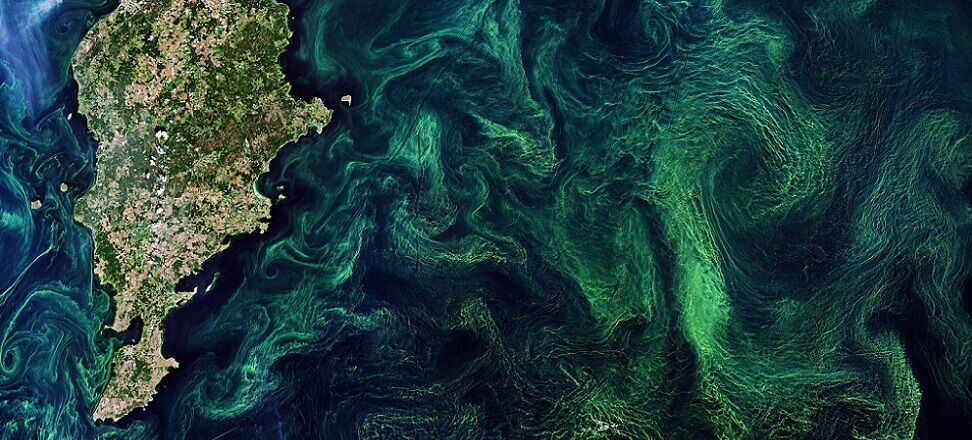Nitrogen is one of the primary biogenic elements responsible for the eutrophication of surface waters. It is part of many compounds and has a relatively complex cycle of circulation in nature. Analyses of water fertility and eutrophication mainly focus on nitrogen bound in nitrate and ammonium ions. The other compounds of this element – nitrites, amines and the like – are taken into account less frequently, mainly as components of the so-called “nitrites”. Mineral and organic nitrogen. Analysis of the element’s gaseous forms – oxides and molecular nitrogen, called atmospheric nitrogen – appears in works on its circulation.
Nitrogen oxides are air pollutants responsible for acid rain and significantly affect water quality. Molecular nitrogen, on the other hand, is mentioned mainly as a product of denitrification in biological wastewater treatment plants. It forms two-atom molecules that escape into the air, from where it can be bound again and end up in the waterways and close the nitrogen cycle. This process often proceeds by diazotrophy.
Diazotrophy, or diversification of nitrogen portfolio
The binding of molecular nitrogen is a process that requires energy. In nature, it is provided by lightning or magnetic storms. At the atmospheric scale, it occurs rarely enough that it does not significantly affect the atmosphere. Therefore, although molecular nitrogen in the form of gas dissolved in water may be , especially in more aerated layers, the most common form of this element, it is not considered a biogenic substance. This form of nitrogen is unpalatable to most organisms due to the energy cost of breaking down a two-atom molecule.
Thus, they capture nitrogen in the form of nitrate ions, less often ammonium (plants) or nitrogenous organic compounds (fungi, animals). Some microorganisms combine both strategies, allowing them to use whichever nitrogen source is easiest to obtain at any given time, and switch to another if it is depleted. This group includes, for example, the haptophyte Prymnesium parvum.
Enzymes such as nitrogenase help reduce the cost of the assimilation process, but for most organisms the cost is still high – breaking down one molecule consumes sixteen molecules of ATP, the universal energy currency of the living world. Therefore, this ability, called diazotrophy, is very rare, limited to the world of bacteria and archaeons. However, these organisms often enter into symbiotic systems with plants, which provide the bacteria with shelter and nutrients, and in return take up bioavailable forms of nitrogen.
In agriculture, this is important in the cultivation of bean (legume) crops, which are thus a rich source of protein for humans and livestock. This is a textbook example. There are also cases that are less well known, but more relevant from an aquatic perspective, when diazotrophic bacteria belong to cyanobacteria. Trichormus azollae (often referred to as Anabaena azollae in the literature) is a diazotrophic symbiont of the aquatic fern azolla, which in rice fields is a green fertilizer like lupine or seradella on arable land. Cyanobacteria of the genus Nostoc, on the other hand, coexist with sagegrouse. They, however, pass not only nitrogen but also toxins to the plant, which can cause neurodegenerative diseases in people who eat sago flour.
Symbiosis of unicellulars, or diazotrophic cyanobacteria support phytoplankton
The above examples involve the symbiosis of bacteria and multicellular plants. Meanwhile, symbiosis remaining in the single-cell world is possible. In the 1990s. Last century, a team that included Jonathan P. Zehr discovered various specimens possessing nitrogenase genes in bacterioplankton samples. They belonged to different groups of bacteria, as well as cyanobacteria. Some were associated with diatoms or planktonic animals such as copepods. Researchers have concluded that in the latter case, diazotrophic bacteria inhabit the animal’s body shells (external or internal, i.e., the intestine), but the exact relationship has not been clarified [1].
A decade later, it was already known that diazotrophic cyanobacteria were quite abundant in the ocean. Initially, the most common type of them seemed to be Trichodesmium. However, subsequent work under Zehr’s direction showed that two groups of single-celled (i.e., non-colony) diazotrophic cyanobacteria were equally common, which came to be known by the working acronyms UCYN-A and UCYN-B. The latter was recognized as a species of Crocosphaera watsonii, but UCYN-A remained unidentified. One reason was the failure of attempts to breed it.
This is because it turned out that the photosynthetic apparatus of these organisms is retrograded, so they must be adulterous. In addition, it is very small, even for a cyanosis. One counterintuitive observation was that UCYN-A is found in nitrate-rich waters where its diazotrophic abilities are not critical for survival. It is also unable to assimilate this form of nitrogen itself [2]. This gave rise to the assumption that it must coexist symbiotically with another organism that also uses nitrates, a representative of phytoplankton.
Further analysis of the metagenome indicated that this partner could be two haptophyte species: Chrysochromulina parkeae (resembling Prymnesium parvum) and Braarudosphaera bigelowii. Based on this, the researchers concluded that the recognition status of UCYN-A justifies the proposal to recognize it as a species with its own name – Atelocyanobacterium thalassa. However, since the authors did not provide the required diagnostic description, the name still has candidate status [3].
Nitroplast, or from symbiont to organellum
Zehr initially surmised that UCYN-A lives on the outside of the cells of its host, the haptophyte Braarudosphaera bigelowii. However, it was soon found to be an endosymbiont. Endosymbiosis is a system in which a symbiont cell lives inside a host cell. It is not uncommon and takes different forms. Often the unicellular algae live in the cells of stoats or corals and are called zoochlorellas or zooxanthellae, depending on their color. Under stress conditions, the host can get rid of them, which is the mechanism responsible for coral fading.
Over time, over the course of evolution, cooperation becomes closer and closer. As a rule, the endosymbiont loses more genes and becomes increasingly simplified. As a result, UCYN-A can no longer assimilate carbon compounds on its own and must obtain them from the haptophyte. This explains why it could not be bred separately. At a certain point, it is no longer possible to speak of two organisms in symbiosis, but of a cell and its organelles. This is how mitochondria and chloroplasts were formed. Some endosymbiotic systems can be so complex that as many as seven genomes can be isolated in a cell.
Zehr, describing in 2015. simplification of the structure of UCYN-A and its close metabolic relationship with the host, he suggested that in principle we can speak of the formation of a cell organellum, which by analogy with the chloroplast he called the nitroplast [4]. Another decade of research confirmed the theory – in the spring of 2024. There have been two publications [5, 6] that show the developmental synchronization necessary for cell division and metabolic interdependence, and a third that summarizes them [7]. Haptophyte and cyanobacteria pass not only simple compounds but also proteins back and forth to each other, and this is already an important rationale for considering them as one organism. Thus, the name nitroplast is no longer hypothetical.
It took a quarter century of research to discover the new organellum. Still not all aspects of this symbiosis are known. By the way, it was learned that diazotrophy is more common than thought. Fossils of the haptophyte in which it was discovered are known from Cretaceous deposits dating back 100 million years. Although it is uncertain what its symbiotic systems looked like at the time, this allows us to assume that this role could be quite significant.
Photo. main: Copernicus
In the article, I used, among other things. From the works:
[1]. Zehr J. P., Mellon M. T., Zani S., 1998. New Nitrogen-Fixing Microorganisms Detected in Oligotrophic Oceans by Amplification of Nitrogenase(nifH) Genes. Appl Environ Microbiol 64: https://doi.org/10.1128/AEM.64.9.3444-3450.1998
[2]. Moisander P. H. Beinart R. A., Hewson I., et al, 2010 Unicellular Cyanobacterial Distributions Broaden the Oceanic N2 Fixation Domain. Science 327,1512-1514. DOI: 10.1126/science.1185468
[3] Thompson A. W., Foster R. A., Krupke A., et al. 2012. a Unicellular Cyanobacterium Symbiotic with a Single-Celled Eukaryotic Alga. Science 337,1546-1550. DOI: 10.1126/science.1222700
[4] Zehr J. P., 2015. How single cells work together. Science 349,1163-1164. DOI: 10.1126/science.aac9752
[5, Massana R., 2024. The nitroplast: A nitrogen-fixing organelle. Science 384,160-161. DOI: 10.1126/science.ado8571
[6], Coale T. H., Loconte V., Turk-Kubo K. A., et al. 2024. Nitrogen-fixing organelles in a marine alga. Science 384,217-222. DOI: 10.1126/science.adk1075
[7] Cornejo-Castillo F. M., Inomura K., Zehr J. P., Follows M. J., 2024. Metabolic trade-offs constrain the cell size ratio in a nitrogen-fixing symbiosis. Cell 187, 1762-1768 doi.org/10.1016/j.cell.2024.02.016

 Polski
Polski






